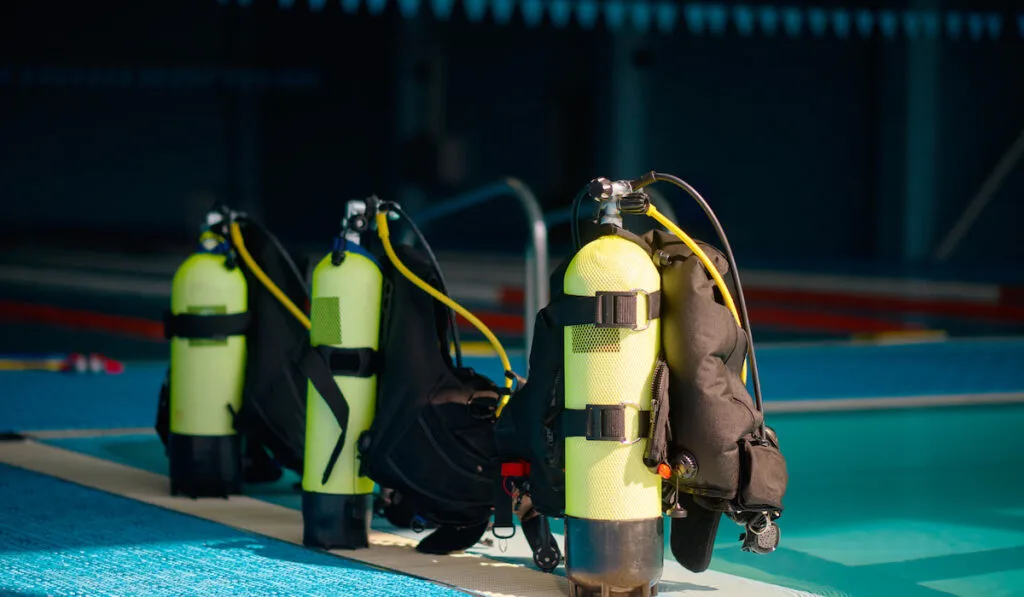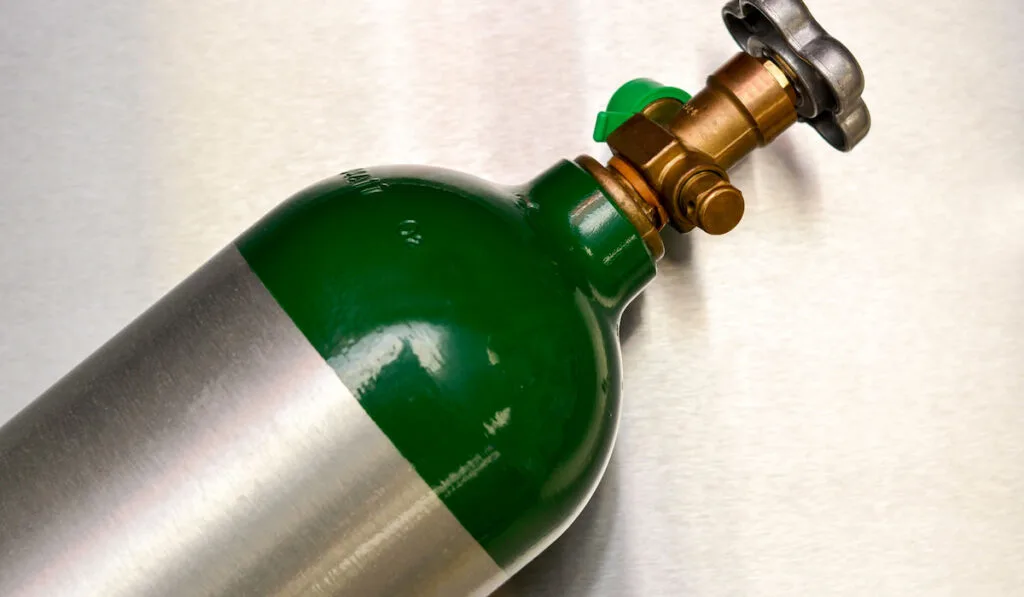*This post may have affiliate links, which means I may receive commissions if you choose to purchase through links I provide (at no extra cost to you). As an Amazon Associate, I earn from qualifying purchases. Please read my disclaimer for additional details.
Oxygen tanks are constructed of one of the strongest aluminum alloys, 6061 aluminum. Does that mean they last forever? Let us see.
Do oxygen tanks go bad?
Oxygen tanks can go bad, which means they are unable to withstand the pressure of the gas stored in them.
Bad oxygen tanks may also develop leaks. Either of these cases is a potential for disaster.
As such, a bad oxygen tank is typically taken out of use.
In this article, we discuss oxygen tanks. We talk about how to store them, what they contain, and how to verify whether they expire or not.
Table of Contents
Do Oxygen Tanks Expire?

Oxygen tanks can expire, but their expiration date is indeterminate. In other words, oxygen tanks do not come with an expiration date for the tank, but they can become unfit for use.
Interestingly, if handled correctly and exposed to minimal damage and wear, an oxygen tank may offer prolonged service life.
Knowing that there is the possibility oxygen tanks might expire, the Department of Transportation (DOT) recommends periodic retesting.
Gas tanks generally come with ratings that define the specifications to which they are made. These ratings are also indicative of the retesting intervals.
Oxygen tanks have a rating of DOT-3AL, and the recommended testing interval for such tanks is 5 years.
Oxygen Tank Retesting
Why are oxygen tanks retested?
Well, oxygen tanks are retested periodically to detect any defect or damage they may have developed. This way, a bad tank can be pulled out of use before it harms anyone.
Once pulled out of use, the cylinder is recycled and used in making a new tank.
Oxygen tank retesting typically involves:
- Visual Inspection
- A Hydrostatic Test
The visual inspection basically involves checking the tank all over with bare eyes. While visual inspection is done during the retesting period, it is recommended that it be performed regularly.
The hydrostatic test, on the other hand, is pretty vital. It verifies that the tank is still strong enough to handle the pressure of the gas. But apart from that, it detects defects and leaks.
So, how is the hydrostatic test done? The tank is filled with water at a pressure higher than the tank’s normal operating pressure.
This test pressure is typically about 1.5 times the operating pressure.
Upon filling the tank with water, the pressure inside it is monitored. If the pressure drops significantly, then there might be a leak or a crack in the tank.
Why Is Water Used for the Hydrostatic Testing?
Water is not very compressible; it will only expand slightly. Therefore, it is unlikely to explode when put under intense pressure, unlike high-pressure gases.

Do Oxygen Tanks Explode?
While such occurrences are rare, oxygen tanks do explode. Such explosions occur when the tank is not used correctly or when there is a leak.
The following are some situations in which oxygen tanks may explode:
- When the materials used with them are not compatible with oxygen. Some incompatible materials are lubricants like grease and oil. You will find that many materials are not compatible with oxygen. So, when replacing any part of your oxygen tank, verify that the replacement is suitable for oxygen service.
- If they are stored incorrectly. Generally, the tanks should be stored away from combustible substances and flammable gases. Oxygen cylinders should also be restrained to keep them from falling.
- If they are used in a confined space. Using oxygen cylinders in confined spaces will lead to oxygen enrichment, which is basically a state of elevated oxygen in the air. Even the slightest elevations in the amount of oxygen in the air may lead to ignition under the right conditions. If this high-pressure oxygen in the tank gets ignited too, the tank may explode.
- If there is a leak. A leak in the tank will lead to oxygen enrichment. Of course, with oxygen enrichment comes a higher probability of ignition. If ignition does occur and the tank gets caught, it may explode.
Do Oxygen Tanks Need to Be Kept Upright?
Oxygen tanks need to be upright most of the time, but not all of the time.
Generally, tanks containing compressed gases should be kept upright in a secured position.
The same applies to oxygen tanks. When they are stored in an upright position, the tanks should be fastened to keep them from falling.
However, for short periods when they are being carried or lifted, oxygen tanks may be on their sides.
All in all, the best position for an oxygen tank is upright.
Do Oxygen Tanks Contain Pure Oxygen?
Oxygen tanks do contain pure oxygen, but the purity is usually not 100%.
Gaseous oxygen is known as Type I Oxygen. It comes in grades ranging from A to F.
Liquefied oxygen is known as Type II. It also comes in grades A to F.
Type I Grade A oxygen is 99% pure, while Grade F oxygen is 99.995% pure. The same values apply to Type II oxygen.
So, while the oxygen in oxygen tanks is of exceedingly high purity, it is never absolutely 100% pure.
Difference Between a Medical Oxygen Tank and a Welding Oxygen Tank

In the past, the primary difference between medical oxygen tanks and welding oxygen tanks was their content. Medical tanks used to contain oxygen of higher purity (99.5%) than welding oxygen tanks.
However, in recent times, both tanks are filled with oxygen of the same production and quality.
Nonetheless, the filling process of medical oxygen tanks and welding oxygen tanks still differs.
When filling medical oxygen tanks, the cylinder is emptied and cleaned to remove any impurity that may harm the patient. After cleaning, the cylinder is then filled with oxygen.
When filling welding oxygen tanks, the cylinder is checked for acetylene. If it contains no acetylene, it is filled directly. On the other hand, if the cylinder contains acetylene, it is emptied before refilling.
Apart from the difference in the refilling process, medical oxygen tanks require a prescription or similar legal document. But welding oxygen tanks do not.
Final Thoughts
Oxygen tanks do go bad. With time, they could become unable to withstand the pressure of the oxygen stored within them. They could also lose their structural integrity and start to leak.
While there is no specified expiry date for oxygen tanks, they are periodically tested to assess their suitability for use. This way, one can spot a cylinder that has gone bad before it does any damage.
Resources
- https://www.seafarma.nl/hydrostatic-pressure-testing-cylinders/
- http://www.madehow.com/Volume-7/Oxygen-Tank.html
- http://www.tymsinc.com/hydrostatic-faq.html
- https://www.ems1.com/explosion/articles/6-steps-to-prevent-an-oxygen-tank-explosionregulator-fire-
- https://www.esfrs.org/EasySiteWeb/GatewayLink.aspx?alId=789
- https://www.osha.gov/laws-regs/standardinterpretations/2010-04-30-4
- https://weldingtroop.com/welding-oxygen-the-same-as-medical-oxygen/
